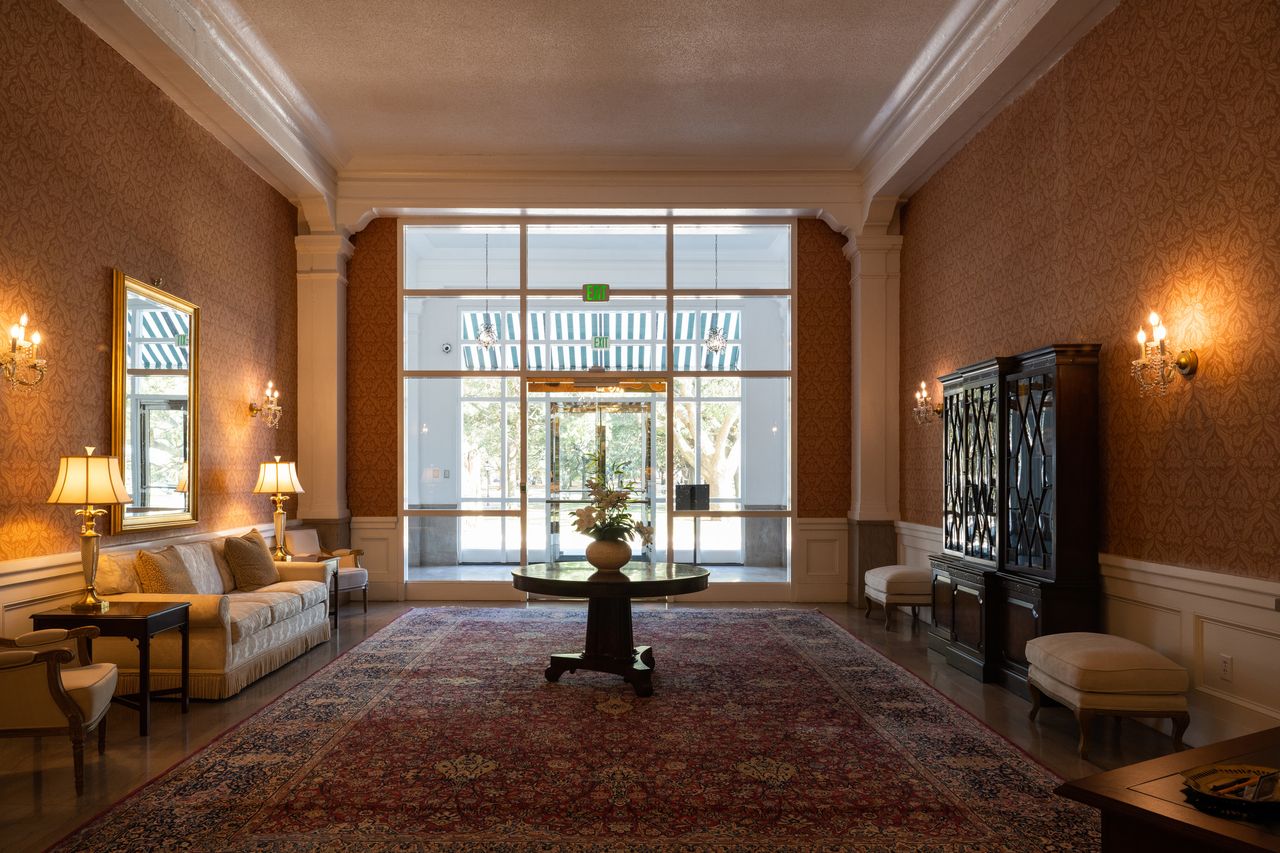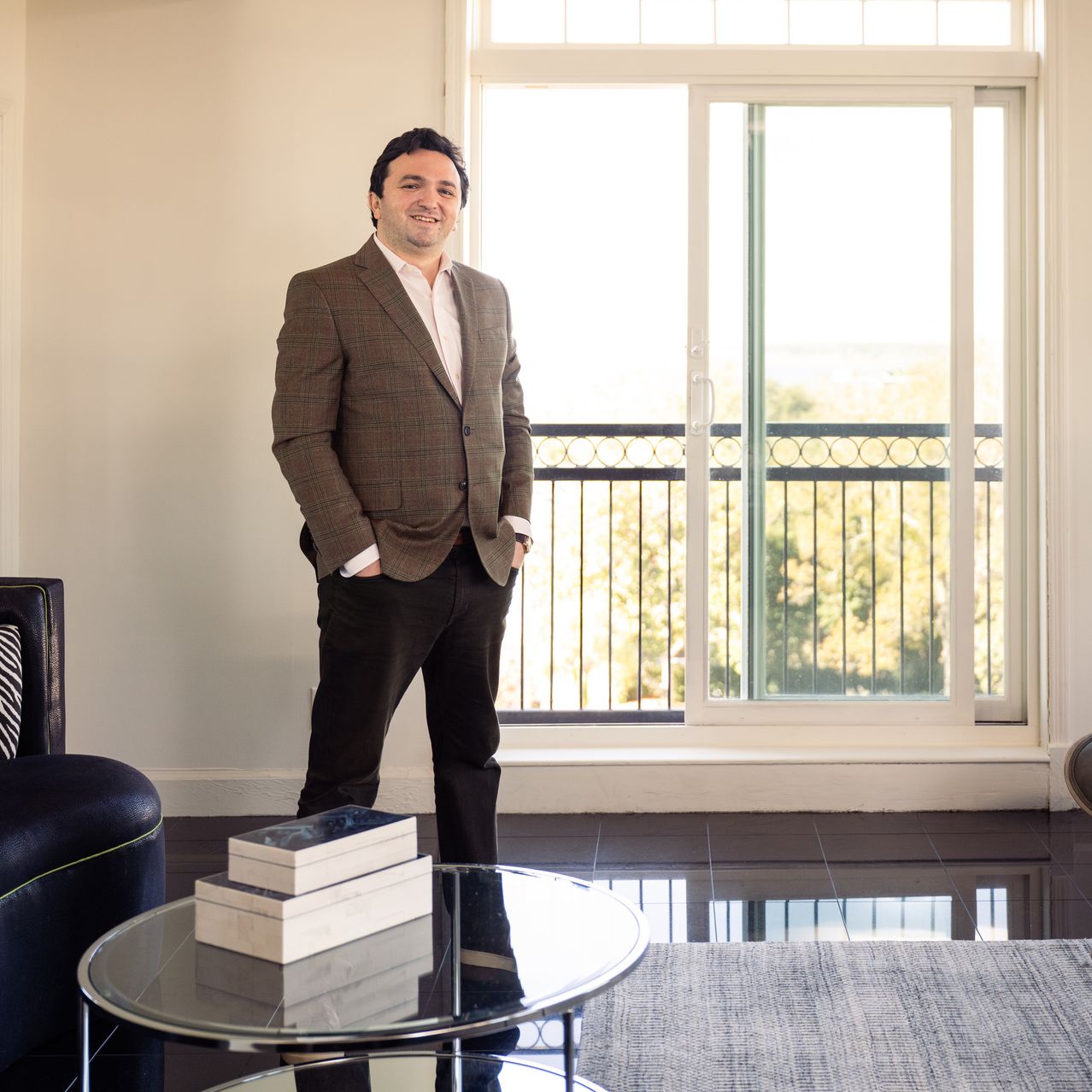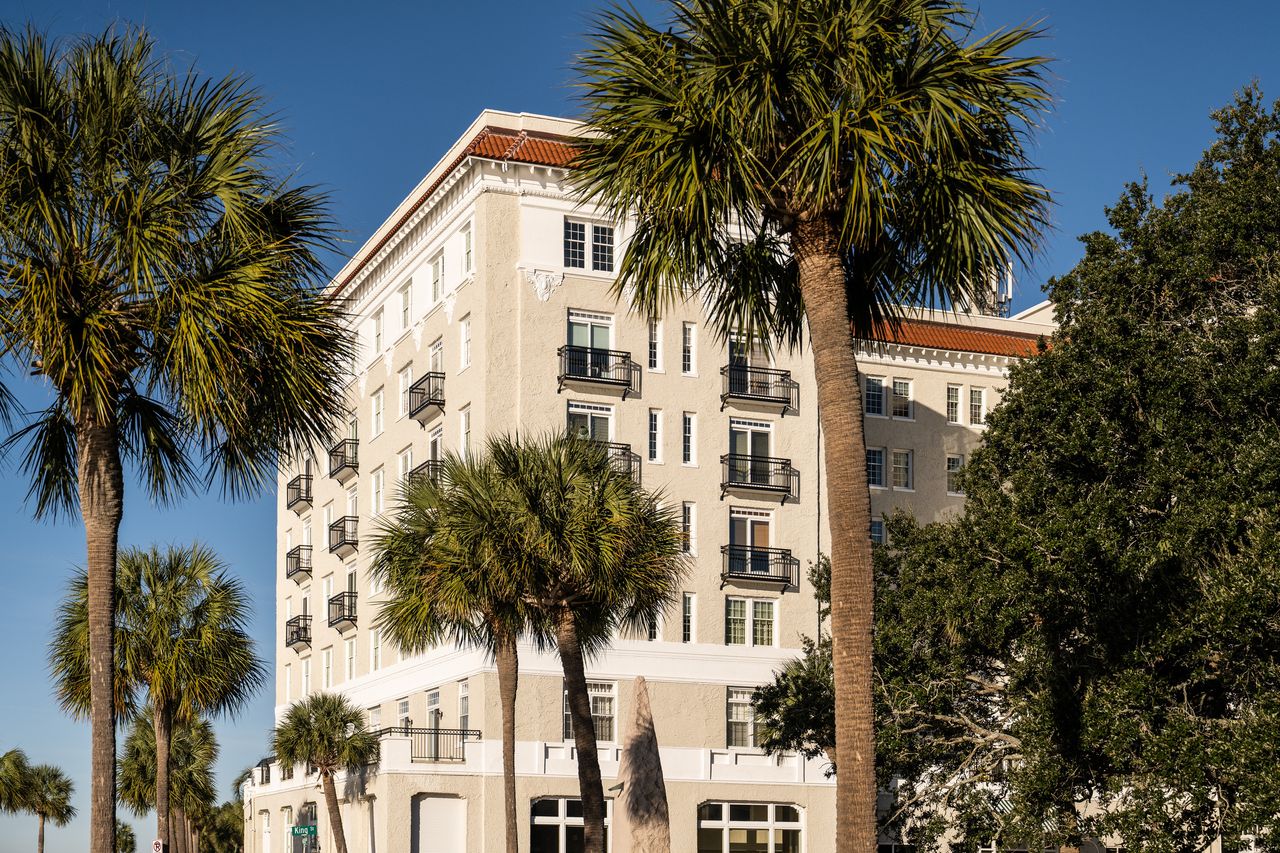Tennessee Williams, JFK and a Suspected Nazi Spy: The History Behind Charleston’s Fort Sumter House
Even at 100 years old, Fort Sumter House is a relative newcomer to Charleston, S.C., where many of the homes date to the 1700s. Nonetheless, this former luxury hotel—now a condominium—touts a rich history.
In the 1940s, visitors to the hotel included playwright Tennessee Williams and a young John F. Kennedy, who used it for a tryst with the Danish journalist Inga Arvad.

But the building is also iconic for its appearance, according to Erin Minnigan of the Preservation Society of Charleston. A rare example of Spanish colonial-revival architecture, Fort Sumter House is the only high-rise building in the South of Broad neighborhood, and will remain so because of height restrictions in the city’s historic districts, she says.
The Fort Sumter House homeowners association recently completed an extensive restoration of the exterior facade, including the stucco and ironwork, working with the preservation society to ensure the building’s historic look remained intact.
“It has become well loved by the citizens of Charleston,” Ms. Minnigan says.
Construction on the Fort Sumter Hotel began in 1923, with the first guests checking in the following year, according to a history maintained by the homeowners association. A centennial celebration is in the works, residents say.
The unusual design of the Fort Sumter Hotel riled some of the locals when construction on the building began, according to some accounts that Ms. Minnigan has read. “At the time preservationists really felt that it was inappropriate—the scale and its modern design. I can certainly see that being the case,” she says. “But that was 100 years ago, and buildings gain significance over time.”
Kennedy, at the time a young Navy officer, stayed at the hotel in 1942 with the charming and beautiful Arvad, says Scott Farris, a presidential scholar and author of “Inga: Kennedy’s Great Love, Hitler’s Perfect Beauty, and J. Edgar Hoover’s Prime Suspect.” The FBI under Hoover also suspected that Arvad was a Nazi spy, Mr. Farris says, and the agency bugged their hotel room.
The Fort Sumter Hotel “was a beautiful place and perfect for a weekend tryst,” says Mr. Farris, who studied former Hoover’s voluminous trove of papers after they were declassified. Arvad’s FBI file is well over 1,000 pages, Mr. Farris says, and eventually the agency decided that she probably wasn’t a spy. “They realized that there was no there there,” he says.
For residents interested in the topic, “JFK and Inga Binga,” a farcical retelling of the Kennedy affair, takes the stage in February at Charleston’s Dock Street Theatre.

In 1947, playwright Tennessee Williams and his literary agent met with theater producer Irene Selznick at the Fort Sumter Hotel to discuss Williams’ latest play, “A Streetcar Named Desire,” according to theater critic and author John Lahr, author of “Tennessee Williams: Mad Pilgrimage of the Flesh.”
Sheraton Hotels purchased the building in 1967 for $435,000 and spent another $500,000 on renovations, according to the homeowners association. In 1973, real-estate investors purchased the hotel and started a $2 million project to convert its 225 rooms into 67 condo units, according to the HOA. Since then, a number of the units have been combined.
Today, what makes this building noteworthy, homeowners say, are its sweeping water views and proximity to the boutique shops and restaurants on the southern end of the city’s peninsula. White Point Garden, a public park, is just steps away from the main entrance of Fort Sumter House.
“We’re in the prime location,” says Katherine Wilkinson, who in 2020 paid $425,000 for a one-bedroom, one-bath condo in Fort Sumter House with her husband, Mark Wilkinson.
“The battery is just outside, and the historic, iconic mansions are breathtaking,” says Ms. Wilkinson, 61, who works in an interior-design showroom. “We pinch ourselves every day. It’s just magic.”
Since 2020, at least 12 units have sold at Fort Sumter House, according to public records. Sale prices range from $387,000 for a roughly 585-square-foot unit to $1.225 million for a two-bedroom, two-bath unit measuring about 1,500 square feet.
In 2021, Josh Nass paid $770,000 for a roughly 1,200-square-foot unit at Fort Sumter House that dwarfed his studio apartment in Manhattan. During the pandemic, “I realized that I didn’t have to be in New York City to work—I could be anywhere,” says Mr. Nass, a 31-year-old crisis-communications specialist.

A friend from Charleston encouraged Mr. Nass to consider the Holy City. After renting briefly, Mr. Nass contacted Douglas Berlinsky at the firm Disher, Hamrick & Myers Real Estate, describing himself as a fervent foodie who loved European architecture and cobblestone streets. Mr. Berlinsky showed him Fort Sumter House because of its historic feel. “Its presence from the street is of an elegant residence,” Mr. Berlinsky says. “It also has amenities that many complexes in the city do not—a pool, a fitness room and [designated] parking.”
Currently, only one apartment at Fort Sumter House is listed for sale: a two-bedroom, two-bath unit on the fourth floor asking $1.19 million. Lee Williams of Oyster Point Realty Group has the listing. At nearly 1,200 square feet, the apartment is one of the more spacious units in the building.
Overall, the inventory of condos in downtown Charleston remains tight, according to an analysis by real-estate website Zillow. In November, 45 condos were on the market, a decrease of 41.6% from the same month in 2021. The median list price for downtown condos on Nov. 30 was $975,000, up 34.5% from a year earlier, Zillow found.
Under Construction in Charleston
Several condo projects are in the works in Charleston. A former Masonic Lodge on Wentworth Street is undergoing a condo conversion, and all 11 units have been presold, according to the developer, East West Partners.
New developments currently under construction include City House Charleston, located in the French Quarter. Carriage Properties is handling presales of 21 condos there, including a three-bedroom, three-bath unit asking $4.2 million. Handsome Properties is marketing four luxury townhomes being built at 122 Beaufain Street in the Harleston Village neighborhood. Currently on the market are two three-bedroom, three-bath units measuring roughly 3,000 square feet and asking $2.55 million each.
New buildings must complement the character of the neighborhood, says Ms. Minnigan of the Preservation Society of Charleston. “The design must blend in with its surroundings,” she says. “At the same time, we don’t want to give a false sense of it being a historic building.”
 Copyright 2020, Dow Jones & Company, Inc. All Rights Reserved Worldwide. LEARN MORE
Copyright 2020, Dow Jones & Company, Inc. All Rights Reserved Worldwide. LEARN MORE
This stylish family home combines a classic palette and finishes with a flexible floorplan
Just 55 minutes from Sydney, make this your creative getaway located in the majestic Hawkesbury region.
Ahead of the Games, a breakdown of the city’s most desirable places to live
PARIS —Paris has long been a byword for luxurious living. The traditional components of the upscale home, from parquet floors to elaborate moldings, have their origins here. Yet settling down in just the right address in this low-rise, high-density city may be the greatest luxury of all.
Tradition reigns supreme in Paris real estate, where certain conditions seem set in stone—the western half of the city, on either side of the Seine, has long been more expensive than the east. But in the fashion world’s capital, parts of the housing market are also subject to shifting fads. In the trendy, hilly northeast, a roving cool factor can send prices in this year’s hip neighborhood rising, while last year’s might seem like a sudden bargain.
This week, with the opening of the Olympic Games and the eyes of the world turned toward Paris, The Wall Street Journal looks at the most expensive and desirable areas in the City of Light.
The Most Expensive Arrondissement: the 6th
Known for historic architecture, elegant apartment houses and bohemian street cred, the 6th Arrondissement is Paris’s answer to Manhattan’s West Village. Like its New York counterpart, the 6th’s starving-artist days are long behind it. But the charm that first wooed notable residents like Gertrude Stein and Jean-Paul Sartre is still largely intact, attracting high-minded tourists and deep-pocketed homeowners who can afford its once-edgy, now serene atmosphere.
Le Breton George V Notaires, a Paris notary with an international clientele, says the 6th consistently holds the title of most expensive arrondissement among Paris’s 20 administrative districts, and 2023 was no exception. Last year, average home prices reached $1,428 a square foot—almost 30% higher than the Paris average of $1,100 a square foot.
According to Meilleurs Agents, the Paris real estate appraisal company, the 6th is also home to three of the city’s five most expensive streets. Rue de Furstemberg, a secluded loop between Boulevard Saint-Germain and the Seine, comes in on top, with average prices of $2,454 a square foot as of March 2024.
For more than two decades, Kyle Branum, a 51-year-old attorney, and Kimberly Branum, a 60-year-old retired CEO, have been regular visitors to Paris, opting for apartment rentals and ultimately an ownership interest in an apartment in the city’s 7th Arrondissement, a sedate Left Bank district known for its discreet atmosphere and plutocratic residents.
“The 7th was the only place we stayed,” says Kimberly, “but we spent most of our time in the 6th.”
In 2022, inspired by the strength of the dollar, the Branums decided to fulfil a longstanding dream of buying in Paris. Working with Paris Property Group, they opted for a 1,465-square-foot, three-bedroom in a building dating to the 17th century on a side street in the 6th Arrondissement. They paid $2.7 million for the unit and then spent just over $1 million on the renovation, working with Franco-American visual artist Monte Laster, who also does interiors.
The couple, who live in Santa Barbara, Calif., plan to spend about three months a year in Paris, hosting children and grandchildren, and cooking after forays to local food markets. Their new kitchen, which includes a French stove from luxury appliance brand Lacanche, is Kimberly’s favourite room, she says.
Another American, investor Ashley Maddox, 49, is also considering relocating.
In 2012, the longtime Paris resident bought a dingy, overstuffed 1,765-square-foot apartment in the 6th and started from scratch. She paid $2.5 million and undertook a gut renovation and building improvements for about $800,000. A centrepiece of the home now is the one-time salon, which was turned into an open-plan kitchen and dining area where Maddox and her three children tend to hang out, American-style. Just outside her door are some of the city’s best-known bakeries and cheesemongers, and she is a short walk from the Jardin du Luxembourg, the Left Bank’s premier green space.
“A lot of the majesty of the city is accessible from here,” she says. “It’s so central, it’s bananas.” Now that two of her children are going away to school, she has listed the four-bedroom apartment with Varenne for $5 million.
The Most Expensive Neighbourhoods: Notre-Dame and Invalides
Garrow Kedigian is moving up in the world of Parisian real estate by heading south of the Seine.
During the pandemic, the Canada-born, New York-based interior designer reassessed his life, he says, and decided “I’m not going to wait any longer to have a pied-à-terre in Paris.”
He originally selected a 1,130-square-foot one-bedroom in the trendy 9th Arrondissement, an up-and-coming Right Bank district just below Montmartre. But he soon realised it was too small for his extended stays, not to mention hosting guests from out of town.
After paying about $1.6 million in 2022 and then investing about $55,000 in new decor, he put the unit up for sale in early 2024 and went house-shopping a second time. He ended up in the Invalides quarter of the 7th Arrondissement in the shadow of one Paris’s signature monuments, the golden-domed Hôtel des Invalides, which dates to the 17th century and is fronted by a grand esplanade.
His new neighbourhood vies for Paris’s most expensive with the Notre-Dame quarter in the 4th Arrondissement, centred on a few islands in the Seine behind its namesake cathedral. According to Le Breton, home prices in the Notre-Dame neighbourhood were $1,818 a square foot in 2023, followed by $1,568 a square foot in Invalides.
After breaking even on his Right Bank one-bedroom, Kedigian paid $2.4 million for his new 1,450-square-foot two-bedroom in a late 19th-century building. It has southern exposures, rounded living-room windows and “gorgeous floors,” he says. Kedigian, who bought the new flat through Junot Fine Properties/Knight Frank, plans to spend up to $435,000 on a renovation that will involve restoring the original 12-foot ceiling height in many of the rooms, as well as rescuing the ceilings’ elaborate stucco detailing. He expects to finish in 2025.
Over in the Notre-Dame neighbourhood, Belles demeures de France/Christie’s recently sold a 2,370-square-foot, four-bedroom home for close to the asking price of about $8.6 million, or about $3,630 a square foot. Listing agent Marie-Hélène Lundgreen says this places the unit near the very top of Paris luxury real estate, where prime homes typically sell between $2,530 and $4,040 a square foot.
The Most Expensive Suburb: Neuilly-sur-Seine
The Boulevard Périphérique, the 22-mile ring road that surrounds Paris and its 20 arrondissements, was once a line in the sand for Parisians, who regarded the French capital’s numerous suburbs as something to drive through on their way to and from vacation. The past few decades have seen waves of gentrification beyond the city’s borders, upgrading humble or industrial districts to the north and east into prime residential areas. And it has turned Neuilly-sur-Seine, just northwest of the city, into a luxury compound of first resort.
In 2023, Neuilly’s average home price of $1,092 a square foot made the leafy, stately community Paris’s most expensive suburb.
Longtime residents, Alain and Michèle Bigio, decided this year is the right time to list their 7,730-square-foot, four-bedroom townhouse on a gated Neuilly street.
The couple, now in their mid 70s, completed the home in 1990, two years after they purchased a small parcel of garden from the owners next door for an undisclosed amount. Having relocated from a white-marble château outside Paris, the couple echoed their previous home by using white- and cream-coloured stone in the new four-story build. The Bigios, who will relocate just back over the border in the 16th Arrondissement, have listed the property with Emile Garcin Propriétés for $14.7 million.
The couple raised two adult children here and undertook upgrades in their empty-nester years—most recently, an indoor pool in the basement and a new elevator.
The cool, pale interiors give way to dark and sardonic images in the former staff’s quarters in the basement where Alain works on his hobby—surreal and satirical paintings, whose risqué content means that his wife prefers they stay downstairs. “I’m not a painter,” he says. “But I paint.”
The Trendiest Arrondissement: the 9th
French interior designer Julie Hamon is theatre royalty. Her grandfather was playwright Jean Anouilh, a giant of 20th-century French literature, and her sister is actress Gwendoline Hamon. The 52-year-old, who divides her time between Paris and the U.K., still remembers when the city’s 9th Arrondissement, where she and her husband bought their 1,885-square-foot duplex in 2017, was a place to have fun rather than put down roots. Now, the 9th is the place to do both.
The 9th, a largely 19th-century district, is Paris at its most urban. But what it lacks in parks and other green spaces, it makes up with nightlife and a bustling street life. Among Paris’s gentrifying districts, which have been transformed since 2000 from near-slums to the brink of luxury, the 9th has emerged as the clear winner. According to Le Breton, average 2023 home prices here were $1,062 a square foot, while its nearest competitors for the cool crown, the 10th and the 11th, have yet to break $1,011 a square foot.
A co-principal in the Bobo Design Studio, Hamon—whose gut renovation includes a dramatic skylight, a home cinema and air conditioning—still seems surprised at how far her arrondissement has come. “The 9th used to be well known for all the theatres, nightclubs and strip clubs,” she says. “But it was never a place where you wanted to live—now it’s the place to be.”
With their youngest child about to go to college, she and her husband, 52-year-old entrepreneur Guillaume Clignet, decided to list their Paris home for $3.45 million and live in London full-time. Propriétés Parisiennes/Sotheby’s is handling the listing, which has just gone into contract after about six months on the market.
The 9th’s music venues were a draw for 44-year-old American musician and piano dealer, Ronen Segev, who divides his time between Miami and a 1,725-square-foot, two-bedroom in the lower reaches of the arrondissement. Aided by Paris Property Group, Segev purchased the apartment at auction during the pandemic, sight unseen, for $1.69 million. He spent $270,000 on a renovation, knocking down a wall to make a larger salon suitable for home concerts.
During the Olympics, Segev is renting out the space for about $22,850 a week to attendees of the Games. Otherwise, he prefers longer-term sublets to visiting musicians for $32,700 a month.
Most Exclusive Address: Avenue Junot
Hidden in the hilly expanses of the 18th Arrondissement lies a legendary street that, for those in the know, is the city’s most exclusive address. Avenue Junot, a bucolic tree-lined lane, is a fairy-tale version of the city, separate from the gritty bustle that surrounds it.
Homes here rarely come up for sale, and, when they do, they tend to be off-market, or sold before they can be listed. Martine Kuperfis—whose Paris-based Junot Group real-estate company is named for the street—says the most expensive units here are penthouses with views over the whole of the city.
In 2021, her agency sold a 3,230-square-foot triplex apartment, with a 1,400-square-foot terrace, for $8.5 million. At about $2,630 a square foot, that is three times the current average price in the whole of the 18th.
Among its current Junot listings is a 1930s 1,220-square-foot townhouse on the avenue’s cobblestone extension, with an asking price of $2.8 million.
This stylish family home combines a classic palette and finishes with a flexible floorplan
Just 55 minutes from Sydney, make this your creative getaway located in the majestic Hawkesbury region.






















